HIV/AIDS Epidemiology and Prevention in the UK
VerifiedAdded on 2020/04/21
|12
|3822
|83
AI Summary
This assignment delves into the complex landscape of HIV/AIDS within the United Kingdom. It requires a critical examination of epidemiological data on incidence, mortality, and co-infections like HCV, alongside an exploration of prevention strategies targeted at specific populations, particularly men who have sex with men (MSM). The analysis should incorporate recent trends, research findings, and the impact of interventions such as pre-exposure prophylaxis (PrEP) and HIV self-testing.
Contribute Materials
Your contribution can guide someone’s learning journey. Share your
documents today.

Running head: HIV IN UK
HIV in UK
Name of the Student
Name of the University
Author note
HIV in UK
Name of the Student
Name of the University
Author note
Secure Best Marks with AI Grader
Need help grading? Try our AI Grader for instant feedback on your assignments.
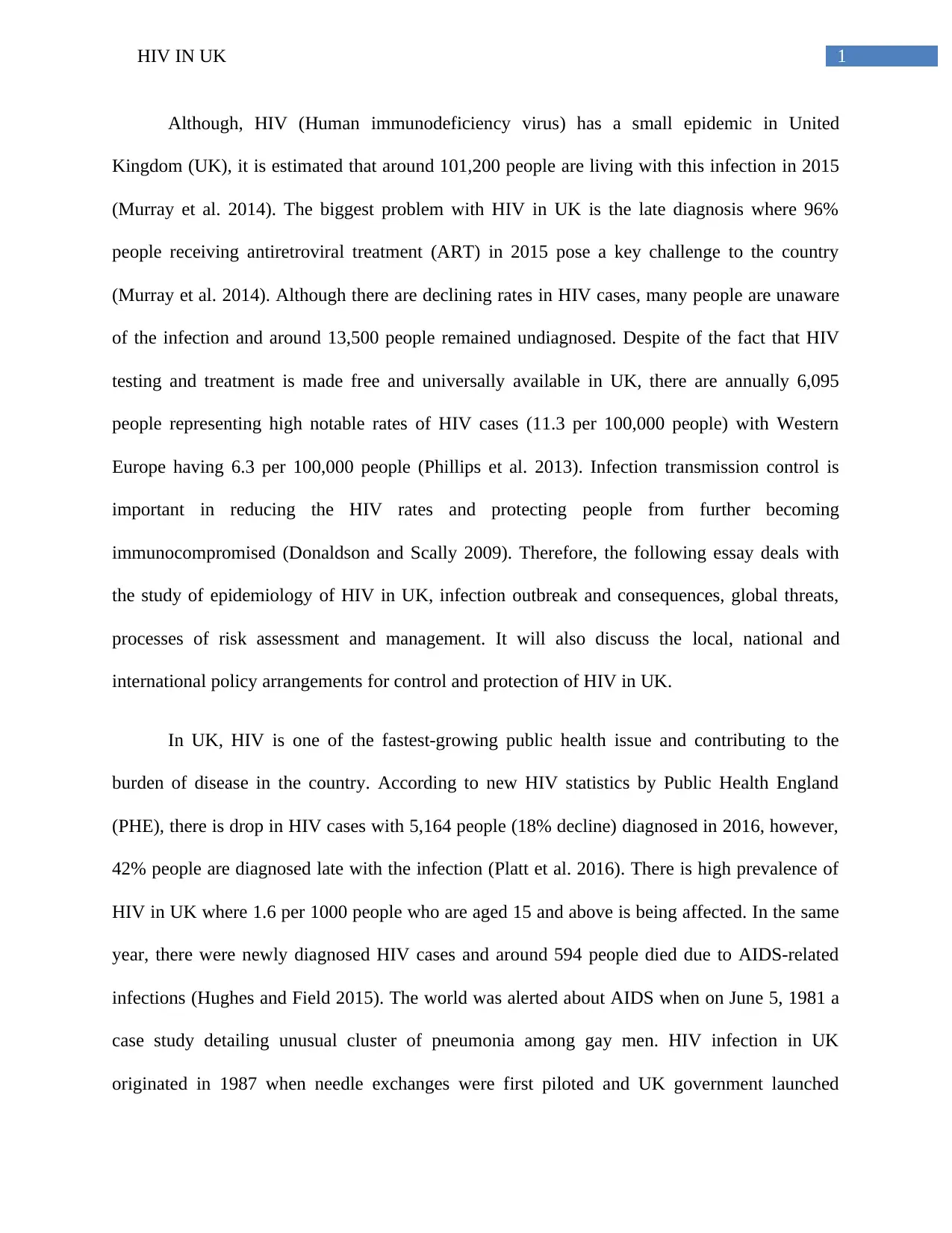
1HIV IN UK
Although, HIV (Human immunodeficiency virus) has a small epidemic in United
Kingdom (UK), it is estimated that around 101,200 people are living with this infection in 2015
(Murray et al. 2014). The biggest problem with HIV in UK is the late diagnosis where 96%
people receiving antiretroviral treatment (ART) in 2015 pose a key challenge to the country
(Murray et al. 2014). Although there are declining rates in HIV cases, many people are unaware
of the infection and around 13,500 people remained undiagnosed. Despite of the fact that HIV
testing and treatment is made free and universally available in UK, there are annually 6,095
people representing high notable rates of HIV cases (11.3 per 100,000 people) with Western
Europe having 6.3 per 100,000 people (Phillips et al. 2013). Infection transmission control is
important in reducing the HIV rates and protecting people from further becoming
immunocompromised (Donaldson and Scally 2009). Therefore, the following essay deals with
the study of epidemiology of HIV in UK, infection outbreak and consequences, global threats,
processes of risk assessment and management. It will also discuss the local, national and
international policy arrangements for control and protection of HIV in UK.
In UK, HIV is one of the fastest-growing public health issue and contributing to the
burden of disease in the country. According to new HIV statistics by Public Health England
(PHE), there is drop in HIV cases with 5,164 people (18% decline) diagnosed in 2016, however,
42% people are diagnosed late with the infection (Platt et al. 2016). There is high prevalence of
HIV in UK where 1.6 per 1000 people who are aged 15 and above is being affected. In the same
year, there were newly diagnosed HIV cases and around 594 people died due to AIDS-related
infections (Hughes and Field 2015). The world was alerted about AIDS when on June 5, 1981 a
case study detailing unusual cluster of pneumonia among gay men. HIV infection in UK
originated in 1987 when needle exchanges were first piloted and UK government launched
Although, HIV (Human immunodeficiency virus) has a small epidemic in United
Kingdom (UK), it is estimated that around 101,200 people are living with this infection in 2015
(Murray et al. 2014). The biggest problem with HIV in UK is the late diagnosis where 96%
people receiving antiretroviral treatment (ART) in 2015 pose a key challenge to the country
(Murray et al. 2014). Although there are declining rates in HIV cases, many people are unaware
of the infection and around 13,500 people remained undiagnosed. Despite of the fact that HIV
testing and treatment is made free and universally available in UK, there are annually 6,095
people representing high notable rates of HIV cases (11.3 per 100,000 people) with Western
Europe having 6.3 per 100,000 people (Phillips et al. 2013). Infection transmission control is
important in reducing the HIV rates and protecting people from further becoming
immunocompromised (Donaldson and Scally 2009). Therefore, the following essay deals with
the study of epidemiology of HIV in UK, infection outbreak and consequences, global threats,
processes of risk assessment and management. It will also discuss the local, national and
international policy arrangements for control and protection of HIV in UK.
In UK, HIV is one of the fastest-growing public health issue and contributing to the
burden of disease in the country. According to new HIV statistics by Public Health England
(PHE), there is drop in HIV cases with 5,164 people (18% decline) diagnosed in 2016, however,
42% people are diagnosed late with the infection (Platt et al. 2016). There is high prevalence of
HIV in UK where 1.6 per 1000 people who are aged 15 and above is being affected. In the same
year, there were newly diagnosed HIV cases and around 594 people died due to AIDS-related
infections (Hughes and Field 2015). The world was alerted about AIDS when on June 5, 1981 a
case study detailing unusual cluster of pneumonia among gay men. HIV infection in UK
originated in 1987 when needle exchanges were first piloted and UK government launched
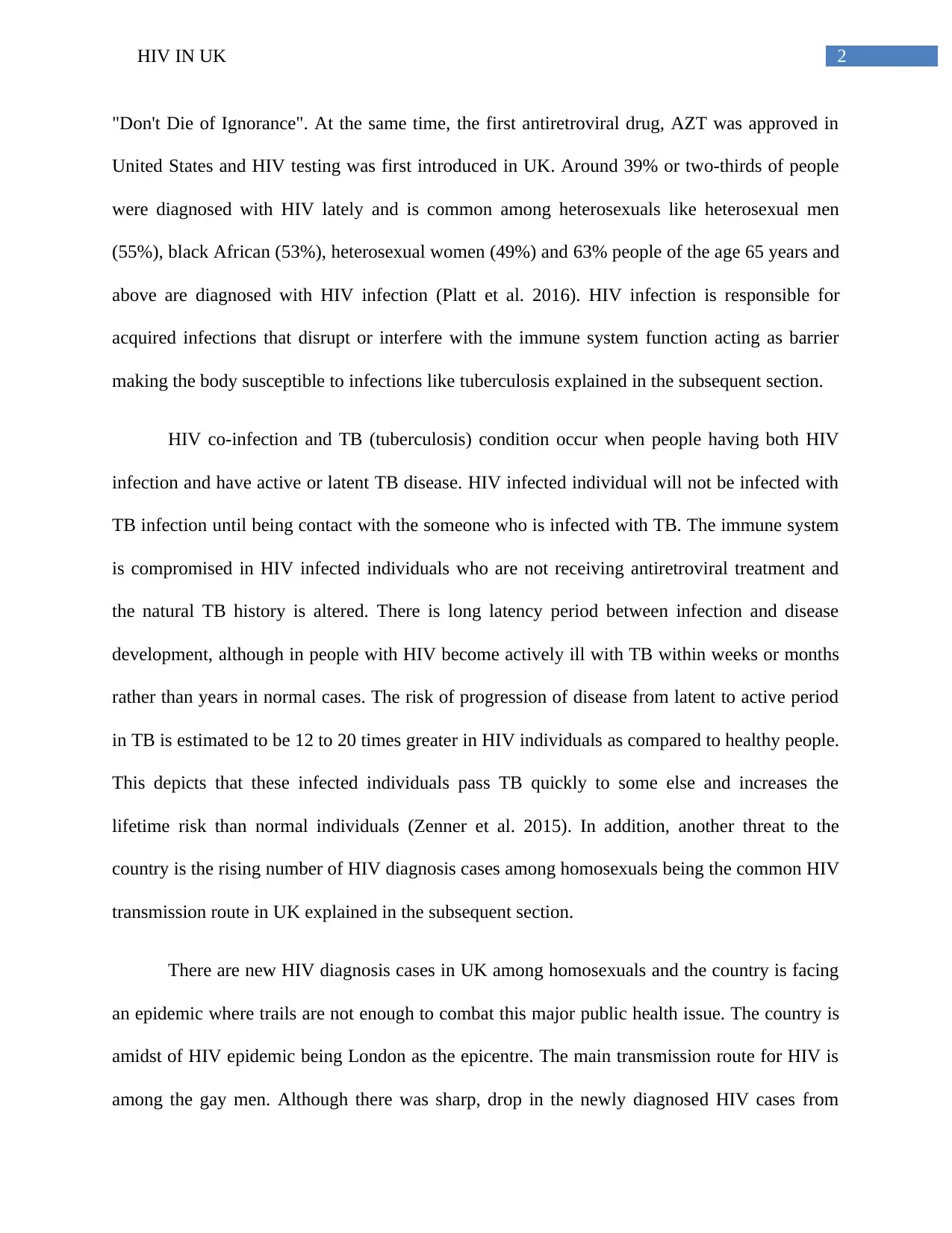
2HIV IN UK
"Don't Die of Ignorance". At the same time, the first antiretroviral drug, AZT was approved in
United States and HIV testing was first introduced in UK. Around 39% or two-thirds of people
were diagnosed with HIV lately and is common among heterosexuals like heterosexual men
(55%), black African (53%), heterosexual women (49%) and 63% people of the age 65 years and
above are diagnosed with HIV infection (Platt et al. 2016). HIV infection is responsible for
acquired infections that disrupt or interfere with the immune system function acting as barrier
making the body susceptible to infections like tuberculosis explained in the subsequent section.
HIV co-infection and TB (tuberculosis) condition occur when people having both HIV
infection and have active or latent TB disease. HIV infected individual will not be infected with
TB infection until being contact with the someone who is infected with TB. The immune system
is compromised in HIV infected individuals who are not receiving antiretroviral treatment and
the natural TB history is altered. There is long latency period between infection and disease
development, although in people with HIV become actively ill with TB within weeks or months
rather than years in normal cases. The risk of progression of disease from latent to active period
in TB is estimated to be 12 to 20 times greater in HIV individuals as compared to healthy people.
This depicts that these infected individuals pass TB quickly to some else and increases the
lifetime risk than normal individuals (Zenner et al. 2015). In addition, another threat to the
country is the rising number of HIV diagnosis cases among homosexuals being the common HIV
transmission route in UK explained in the subsequent section.
There are new HIV diagnosis cases in UK among homosexuals and the country is facing
an epidemic where trails are not enough to combat this major public health issue. The country is
amidst of HIV epidemic being London as the epicentre. The main transmission route for HIV is
among the gay men. Although there was sharp, drop in the newly diagnosed HIV cases from
"Don't Die of Ignorance". At the same time, the first antiretroviral drug, AZT was approved in
United States and HIV testing was first introduced in UK. Around 39% or two-thirds of people
were diagnosed with HIV lately and is common among heterosexuals like heterosexual men
(55%), black African (53%), heterosexual women (49%) and 63% people of the age 65 years and
above are diagnosed with HIV infection (Platt et al. 2016). HIV infection is responsible for
acquired infections that disrupt or interfere with the immune system function acting as barrier
making the body susceptible to infections like tuberculosis explained in the subsequent section.
HIV co-infection and TB (tuberculosis) condition occur when people having both HIV
infection and have active or latent TB disease. HIV infected individual will not be infected with
TB infection until being contact with the someone who is infected with TB. The immune system
is compromised in HIV infected individuals who are not receiving antiretroviral treatment and
the natural TB history is altered. There is long latency period between infection and disease
development, although in people with HIV become actively ill with TB within weeks or months
rather than years in normal cases. The risk of progression of disease from latent to active period
in TB is estimated to be 12 to 20 times greater in HIV individuals as compared to healthy people.
This depicts that these infected individuals pass TB quickly to some else and increases the
lifetime risk than normal individuals (Zenner et al. 2015). In addition, another threat to the
country is the rising number of HIV diagnosis cases among homosexuals being the common HIV
transmission route in UK explained in the subsequent section.
There are new HIV diagnosis cases in UK among homosexuals and the country is facing
an epidemic where trails are not enough to combat this major public health issue. The country is
amidst of HIV epidemic being London as the epicentre. The main transmission route for HIV is
among the gay men. Although there was sharp, drop in the newly diagnosed HIV cases from
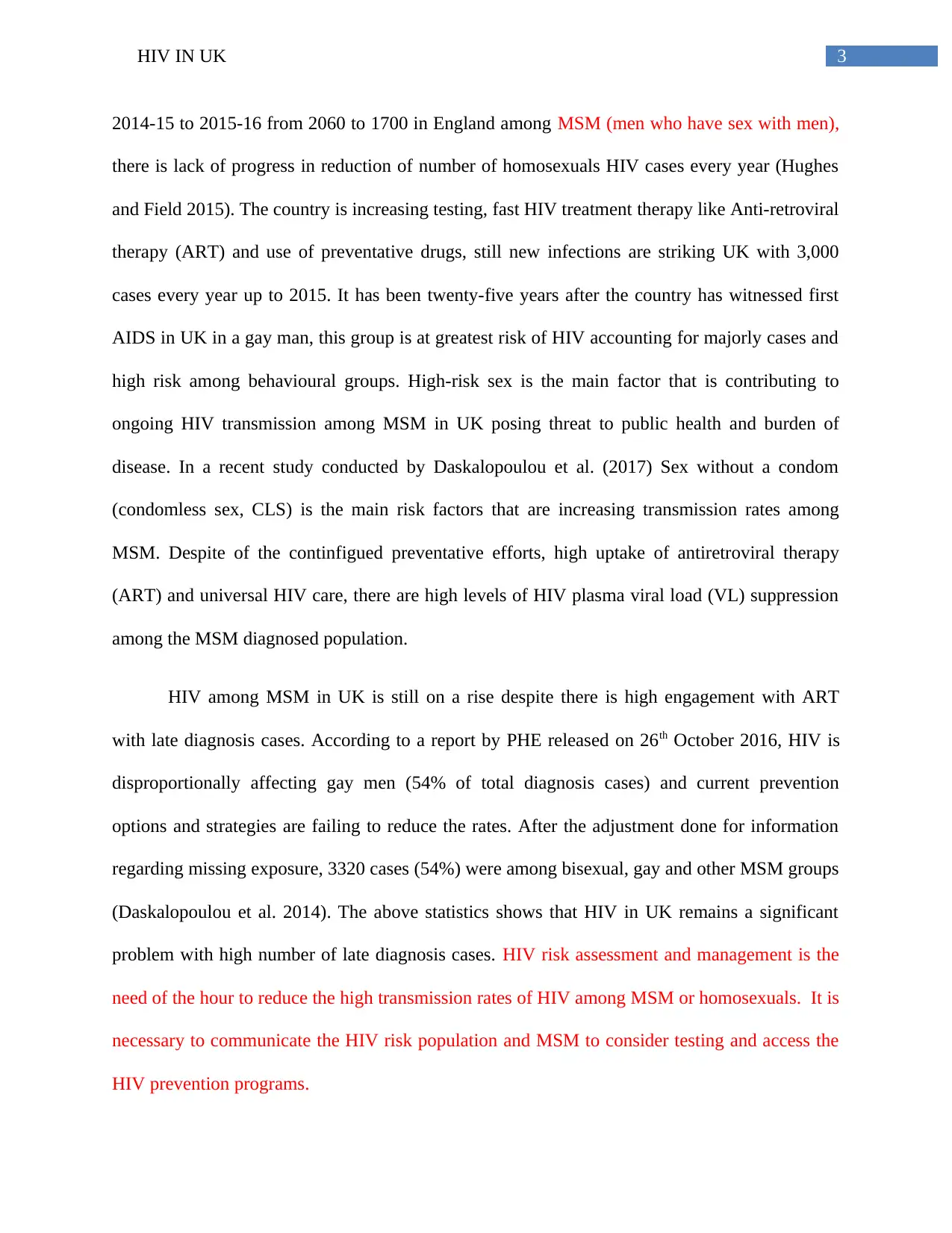
3HIV IN UK
2014-15 to 2015-16 from 2060 to 1700 in England among MSM (men who have sex with men),
there is lack of progress in reduction of number of homosexuals HIV cases every year (Hughes
and Field 2015). The country is increasing testing, fast HIV treatment therapy like Anti-retroviral
therapy (ART) and use of preventative drugs, still new infections are striking UK with 3,000
cases every year up to 2015. It has been twenty-five years after the country has witnessed first
AIDS in UK in a gay man, this group is at greatest risk of HIV accounting for majorly cases and
high risk among behavioural groups. High-risk sex is the main factor that is contributing to
ongoing HIV transmission among MSM in UK posing threat to public health and burden of
disease. In a recent study conducted by Daskalopoulou et al. (2017) Sex without a condom
(condomless sex, CLS) is the main risk factors that are increasing transmission rates among
MSM. Despite of the continfigued preventative efforts, high uptake of antiretroviral therapy
(ART) and universal HIV care, there are high levels of HIV plasma viral load (VL) suppression
among the MSM diagnosed population.
HIV among MSM in UK is still on a rise despite there is high engagement with ART
with late diagnosis cases. According to a report by PHE released on 26th October 2016, HIV is
disproportionally affecting gay men (54% of total diagnosis cases) and current prevention
options and strategies are failing to reduce the rates. After the adjustment done for information
regarding missing exposure, 3320 cases (54%) were among bisexual, gay and other MSM groups
(Daskalopoulou et al. 2014). The above statistics shows that HIV in UK remains a significant
problem with high number of late diagnosis cases. HIV risk assessment and management is the
need of the hour to reduce the high transmission rates of HIV among MSM or homosexuals. It is
necessary to communicate the HIV risk population and MSM to consider testing and access the
HIV prevention programs.
2014-15 to 2015-16 from 2060 to 1700 in England among MSM (men who have sex with men),
there is lack of progress in reduction of number of homosexuals HIV cases every year (Hughes
and Field 2015). The country is increasing testing, fast HIV treatment therapy like Anti-retroviral
therapy (ART) and use of preventative drugs, still new infections are striking UK with 3,000
cases every year up to 2015. It has been twenty-five years after the country has witnessed first
AIDS in UK in a gay man, this group is at greatest risk of HIV accounting for majorly cases and
high risk among behavioural groups. High-risk sex is the main factor that is contributing to
ongoing HIV transmission among MSM in UK posing threat to public health and burden of
disease. In a recent study conducted by Daskalopoulou et al. (2017) Sex without a condom
(condomless sex, CLS) is the main risk factors that are increasing transmission rates among
MSM. Despite of the continfigued preventative efforts, high uptake of antiretroviral therapy
(ART) and universal HIV care, there are high levels of HIV plasma viral load (VL) suppression
among the MSM diagnosed population.
HIV among MSM in UK is still on a rise despite there is high engagement with ART
with late diagnosis cases. According to a report by PHE released on 26th October 2016, HIV is
disproportionally affecting gay men (54% of total diagnosis cases) and current prevention
options and strategies are failing to reduce the rates. After the adjustment done for information
regarding missing exposure, 3320 cases (54%) were among bisexual, gay and other MSM groups
(Daskalopoulou et al. 2014). The above statistics shows that HIV in UK remains a significant
problem with high number of late diagnosis cases. HIV risk assessment and management is the
need of the hour to reduce the high transmission rates of HIV among MSM or homosexuals. It is
necessary to communicate the HIV risk population and MSM to consider testing and access the
HIV prevention programs.
Secure Best Marks with AI Grader
Need help grading? Try our AI Grader for instant feedback on your assignments.
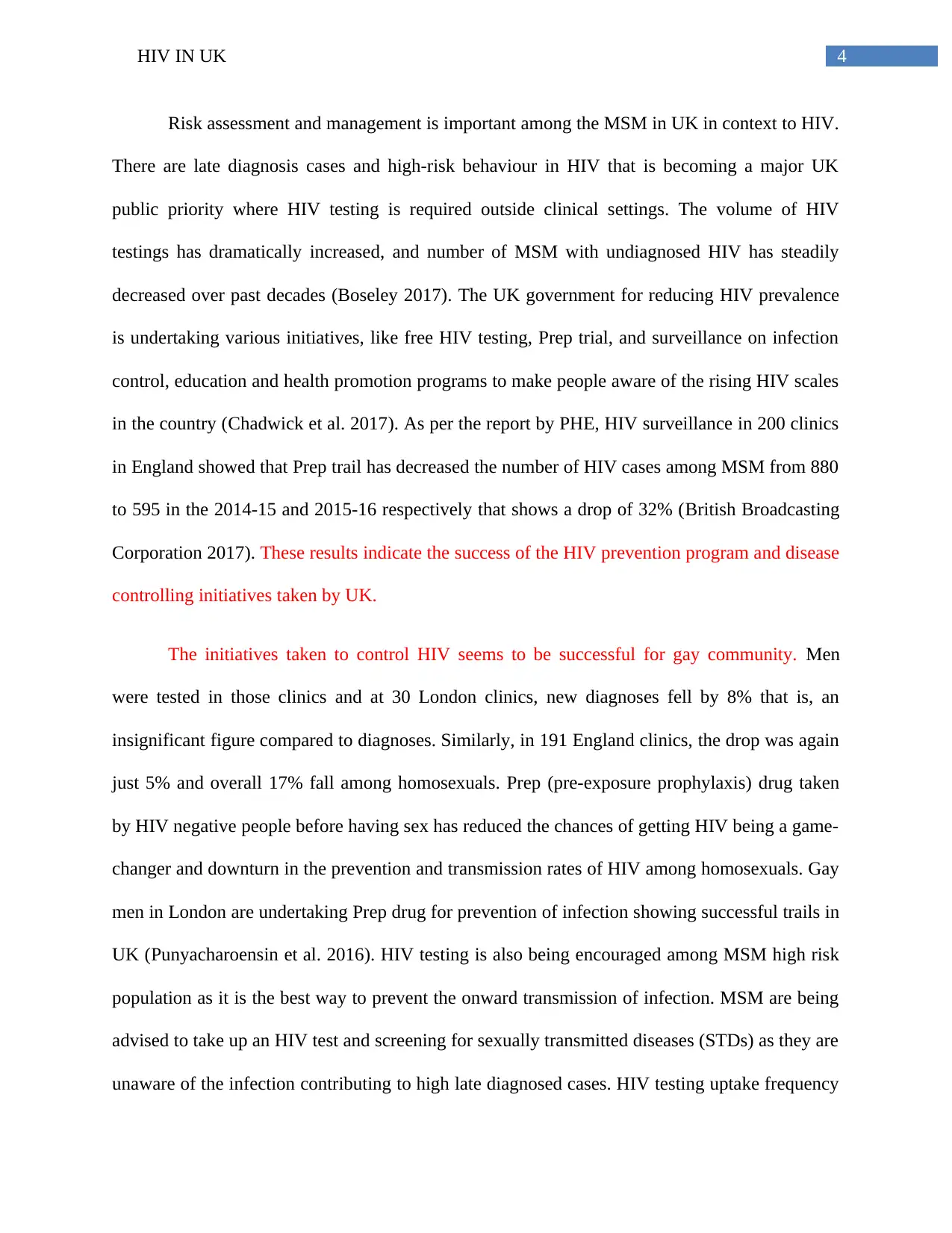
4HIV IN UK
Risk assessment and management is important among the MSM in UK in context to HIV.
There are late diagnosis cases and high-risk behaviour in HIV that is becoming a major UK
public priority where HIV testing is required outside clinical settings. The volume of HIV
testings has dramatically increased, and number of MSM with undiagnosed HIV has steadily
decreased over past decades (Boseley 2017). The UK government for reducing HIV prevalence
is undertaking various initiatives, like free HIV testing, Prep trial, and surveillance on infection
control, education and health promotion programs to make people aware of the rising HIV scales
in the country (Chadwick et al. 2017). As per the report by PHE, HIV surveillance in 200 clinics
in England showed that Prep trail has decreased the number of HIV cases among MSM from 880
to 595 in the 2014-15 and 2015-16 respectively that shows a drop of 32% (British Broadcasting
Corporation 2017). These results indicate the success of the HIV prevention program and disease
controlling initiatives taken by UK.
The initiatives taken to control HIV seems to be successful for gay community. Men
were tested in those clinics and at 30 London clinics, new diagnoses fell by 8% that is, an
insignificant figure compared to diagnoses. Similarly, in 191 England clinics, the drop was again
just 5% and overall 17% fall among homosexuals. Prep (pre-exposure prophylaxis) drug taken
by HIV negative people before having sex has reduced the chances of getting HIV being a game-
changer and downturn in the prevention and transmission rates of HIV among homosexuals. Gay
men in London are undertaking Prep drug for prevention of infection showing successful trails in
UK (Punyacharoensin et al. 2016). HIV testing is also being encouraged among MSM high risk
population as it is the best way to prevent the onward transmission of infection. MSM are being
advised to take up an HIV test and screening for sexually transmitted diseases (STDs) as they are
unaware of the infection contributing to high late diagnosed cases. HIV testing uptake frequency
Risk assessment and management is important among the MSM in UK in context to HIV.
There are late diagnosis cases and high-risk behaviour in HIV that is becoming a major UK
public priority where HIV testing is required outside clinical settings. The volume of HIV
testings has dramatically increased, and number of MSM with undiagnosed HIV has steadily
decreased over past decades (Boseley 2017). The UK government for reducing HIV prevalence
is undertaking various initiatives, like free HIV testing, Prep trial, and surveillance on infection
control, education and health promotion programs to make people aware of the rising HIV scales
in the country (Chadwick et al. 2017). As per the report by PHE, HIV surveillance in 200 clinics
in England showed that Prep trail has decreased the number of HIV cases among MSM from 880
to 595 in the 2014-15 and 2015-16 respectively that shows a drop of 32% (British Broadcasting
Corporation 2017). These results indicate the success of the HIV prevention program and disease
controlling initiatives taken by UK.
The initiatives taken to control HIV seems to be successful for gay community. Men
were tested in those clinics and at 30 London clinics, new diagnoses fell by 8% that is, an
insignificant figure compared to diagnoses. Similarly, in 191 England clinics, the drop was again
just 5% and overall 17% fall among homosexuals. Prep (pre-exposure prophylaxis) drug taken
by HIV negative people before having sex has reduced the chances of getting HIV being a game-
changer and downturn in the prevention and transmission rates of HIV among homosexuals. Gay
men in London are undertaking Prep drug for prevention of infection showing successful trails in
UK (Punyacharoensin et al. 2016). HIV testing is also being encouraged among MSM high risk
population as it is the best way to prevent the onward transmission of infection. MSM are being
advised to take up an HIV test and screening for sexually transmitted diseases (STDs) as they are
unaware of the infection contributing to high late diagnosed cases. HIV testing uptake frequency
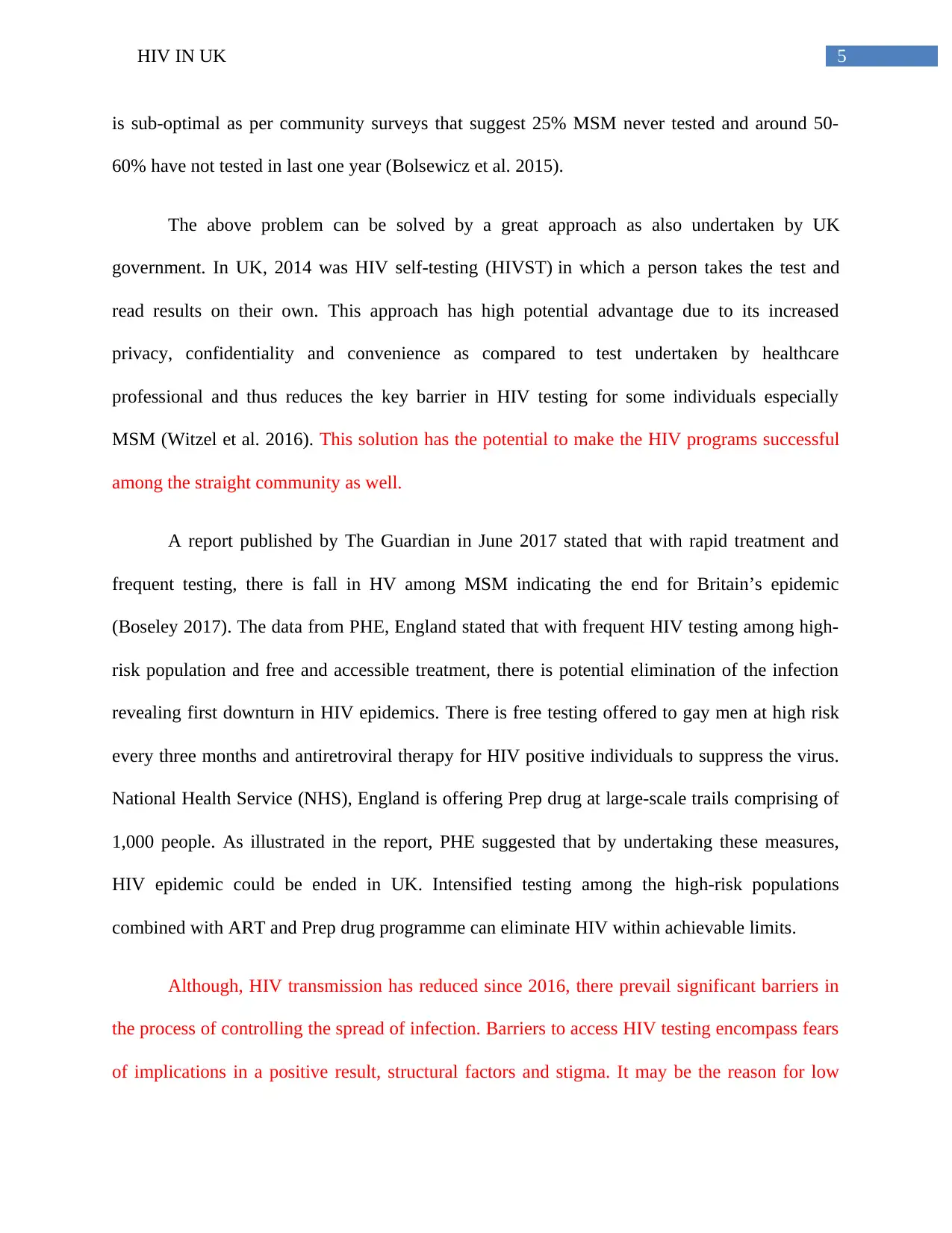
5HIV IN UK
is sub-optimal as per community surveys that suggest 25% MSM never tested and around 50-
60% have not tested in last one year (Bolsewicz et al. 2015).
The above problem can be solved by a great approach as also undertaken by UK
government. In UK, 2014 was HIV self-testing (HIVST) in which a person takes the test and
read results on their own. This approach has high potential advantage due to its increased
privacy, confidentiality and convenience as compared to test undertaken by healthcare
professional and thus reduces the key barrier in HIV testing for some individuals especially
MSM (Witzel et al. 2016). This solution has the potential to make the HIV programs successful
among the straight community as well.
A report published by The Guardian in June 2017 stated that with rapid treatment and
frequent testing, there is fall in HV among MSM indicating the end for Britain’s epidemic
(Boseley 2017). The data from PHE, England stated that with frequent HIV testing among high-
risk population and free and accessible treatment, there is potential elimination of the infection
revealing first downturn in HIV epidemics. There is free testing offered to gay men at high risk
every three months and antiretroviral therapy for HIV positive individuals to suppress the virus.
National Health Service (NHS), England is offering Prep drug at large-scale trails comprising of
1,000 people. As illustrated in the report, PHE suggested that by undertaking these measures,
HIV epidemic could be ended in UK. Intensified testing among the high-risk populations
combined with ART and Prep drug programme can eliminate HIV within achievable limits.
Although, HIV transmission has reduced since 2016, there prevail significant barriers in
the process of controlling the spread of infection. Barriers to access HIV testing encompass fears
of implications in a positive result, structural factors and stigma. It may be the reason for low
is sub-optimal as per community surveys that suggest 25% MSM never tested and around 50-
60% have not tested in last one year (Bolsewicz et al. 2015).
The above problem can be solved by a great approach as also undertaken by UK
government. In UK, 2014 was HIV self-testing (HIVST) in which a person takes the test and
read results on their own. This approach has high potential advantage due to its increased
privacy, confidentiality and convenience as compared to test undertaken by healthcare
professional and thus reduces the key barrier in HIV testing for some individuals especially
MSM (Witzel et al. 2016). This solution has the potential to make the HIV programs successful
among the straight community as well.
A report published by The Guardian in June 2017 stated that with rapid treatment and
frequent testing, there is fall in HV among MSM indicating the end for Britain’s epidemic
(Boseley 2017). The data from PHE, England stated that with frequent HIV testing among high-
risk population and free and accessible treatment, there is potential elimination of the infection
revealing first downturn in HIV epidemics. There is free testing offered to gay men at high risk
every three months and antiretroviral therapy for HIV positive individuals to suppress the virus.
National Health Service (NHS), England is offering Prep drug at large-scale trails comprising of
1,000 people. As illustrated in the report, PHE suggested that by undertaking these measures,
HIV epidemic could be ended in UK. Intensified testing among the high-risk populations
combined with ART and Prep drug programme can eliminate HIV within achievable limits.
Although, HIV transmission has reduced since 2016, there prevail significant barriers in
the process of controlling the spread of infection. Barriers to access HIV testing encompass fears
of implications in a positive result, structural factors and stigma. It may be the reason for low
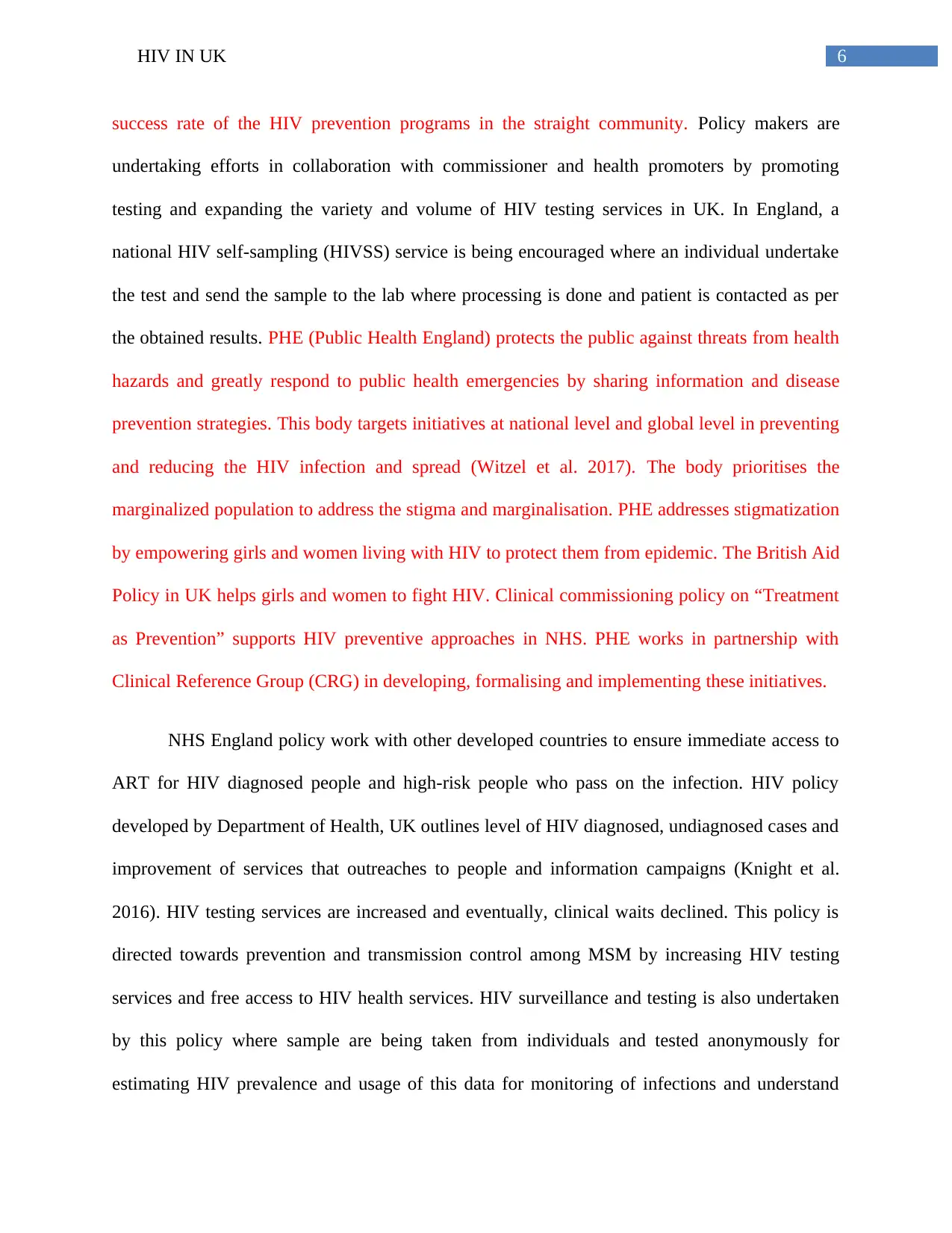
6HIV IN UK
success rate of the HIV prevention programs in the straight community. Policy makers are
undertaking efforts in collaboration with commissioner and health promoters by promoting
testing and expanding the variety and volume of HIV testing services in UK. In England, a
national HIV self-sampling (HIVSS) service is being encouraged where an individual undertake
the test and send the sample to the lab where processing is done and patient is contacted as per
the obtained results. PHE (Public Health England) protects the public against threats from health
hazards and greatly respond to public health emergencies by sharing information and disease
prevention strategies. This body targets initiatives at national level and global level in preventing
and reducing the HIV infection and spread (Witzel et al. 2017). The body prioritises the
marginalized population to address the stigma and marginalisation. PHE addresses stigmatization
by empowering girls and women living with HIV to protect them from epidemic. The British Aid
Policy in UK helps girls and women to fight HIV. Clinical commissioning policy on “Treatment
as Prevention” supports HIV preventive approaches in NHS. PHE works in partnership with
Clinical Reference Group (CRG) in developing, formalising and implementing these initiatives.
NHS England policy work with other developed countries to ensure immediate access to
ART for HIV diagnosed people and high-risk people who pass on the infection. HIV policy
developed by Department of Health, UK outlines level of HIV diagnosed, undiagnosed cases and
improvement of services that outreaches to people and information campaigns (Knight et al.
2016). HIV testing services are increased and eventually, clinical waits declined. This policy is
directed towards prevention and transmission control among MSM by increasing HIV testing
services and free access to HIV health services. HIV surveillance and testing is also undertaken
by this policy where sample are being taken from individuals and tested anonymously for
estimating HIV prevalence and usage of this data for monitoring of infections and understand
success rate of the HIV prevention programs in the straight community. Policy makers are
undertaking efforts in collaboration with commissioner and health promoters by promoting
testing and expanding the variety and volume of HIV testing services in UK. In England, a
national HIV self-sampling (HIVSS) service is being encouraged where an individual undertake
the test and send the sample to the lab where processing is done and patient is contacted as per
the obtained results. PHE (Public Health England) protects the public against threats from health
hazards and greatly respond to public health emergencies by sharing information and disease
prevention strategies. This body targets initiatives at national level and global level in preventing
and reducing the HIV infection and spread (Witzel et al. 2017). The body prioritises the
marginalized population to address the stigma and marginalisation. PHE addresses stigmatization
by empowering girls and women living with HIV to protect them from epidemic. The British Aid
Policy in UK helps girls and women to fight HIV. Clinical commissioning policy on “Treatment
as Prevention” supports HIV preventive approaches in NHS. PHE works in partnership with
Clinical Reference Group (CRG) in developing, formalising and implementing these initiatives.
NHS England policy work with other developed countries to ensure immediate access to
ART for HIV diagnosed people and high-risk people who pass on the infection. HIV policy
developed by Department of Health, UK outlines level of HIV diagnosed, undiagnosed cases and
improvement of services that outreaches to people and information campaigns (Knight et al.
2016). HIV testing services are increased and eventually, clinical waits declined. This policy is
directed towards prevention and transmission control among MSM by increasing HIV testing
services and free access to HIV health services. HIV surveillance and testing is also undertaken
by this policy where sample are being taken from individuals and tested anonymously for
estimating HIV prevalence and usage of this data for monitoring of infections and understand
Paraphrase This Document
Need a fresh take? Get an instant paraphrase of this document with our AI Paraphraser
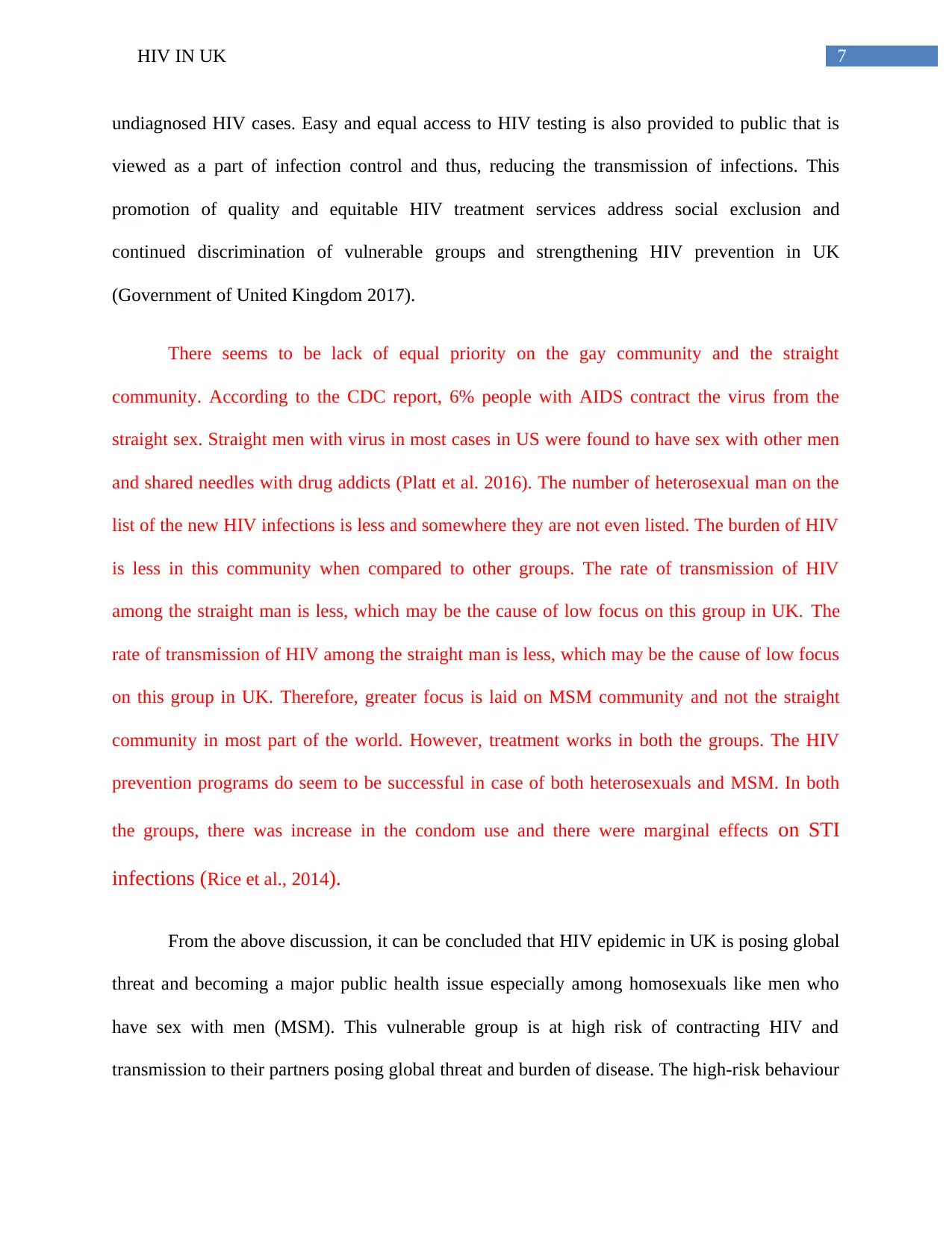
7HIV IN UK
undiagnosed HIV cases. Easy and equal access to HIV testing is also provided to public that is
viewed as a part of infection control and thus, reducing the transmission of infections. This
promotion of quality and equitable HIV treatment services address social exclusion and
continued discrimination of vulnerable groups and strengthening HIV prevention in UK
(Government of United Kingdom 2017).
There seems to be lack of equal priority on the gay community and the straight
community. According to the CDC report, 6% people with AIDS contract the virus from the
straight sex. Straight men with virus in most cases in US were found to have sex with other men
and shared needles with drug addicts (Platt et al. 2016). The number of heterosexual man on the
list of the new HIV infections is less and somewhere they are not even listed. The burden of HIV
is less in this community when compared to other groups. The rate of transmission of HIV
among the straight man is less, which may be the cause of low focus on this group in UK. The
rate of transmission of HIV among the straight man is less, which may be the cause of low focus
on this group in UK. Therefore, greater focus is laid on MSM community and not the straight
community in most part of the world. However, treatment works in both the groups. The HIV
prevention programs do seem to be successful in case of both heterosexuals and MSM. In both
the groups, there was increase in the condom use and there were marginal effects on STI
infections (Rice et al., 2014).
From the above discussion, it can be concluded that HIV epidemic in UK is posing global
threat and becoming a major public health issue especially among homosexuals like men who
have sex with men (MSM). This vulnerable group is at high risk of contracting HIV and
transmission to their partners posing global threat and burden of disease. The high-risk behaviour
undiagnosed HIV cases. Easy and equal access to HIV testing is also provided to public that is
viewed as a part of infection control and thus, reducing the transmission of infections. This
promotion of quality and equitable HIV treatment services address social exclusion and
continued discrimination of vulnerable groups and strengthening HIV prevention in UK
(Government of United Kingdom 2017).
There seems to be lack of equal priority on the gay community and the straight
community. According to the CDC report, 6% people with AIDS contract the virus from the
straight sex. Straight men with virus in most cases in US were found to have sex with other men
and shared needles with drug addicts (Platt et al. 2016). The number of heterosexual man on the
list of the new HIV infections is less and somewhere they are not even listed. The burden of HIV
is less in this community when compared to other groups. The rate of transmission of HIV
among the straight man is less, which may be the cause of low focus on this group in UK. The
rate of transmission of HIV among the straight man is less, which may be the cause of low focus
on this group in UK. Therefore, greater focus is laid on MSM community and not the straight
community in most part of the world. However, treatment works in both the groups. The HIV
prevention programs do seem to be successful in case of both heterosexuals and MSM. In both
the groups, there was increase in the condom use and there were marginal effects on STI
infections (Rice et al., 2014).
From the above discussion, it can be concluded that HIV epidemic in UK is posing global
threat and becoming a major public health issue especially among homosexuals like men who
have sex with men (MSM). This vulnerable group is at high risk of contracting HIV and
transmission to their partners posing global threat and burden of disease. The high-risk behaviour
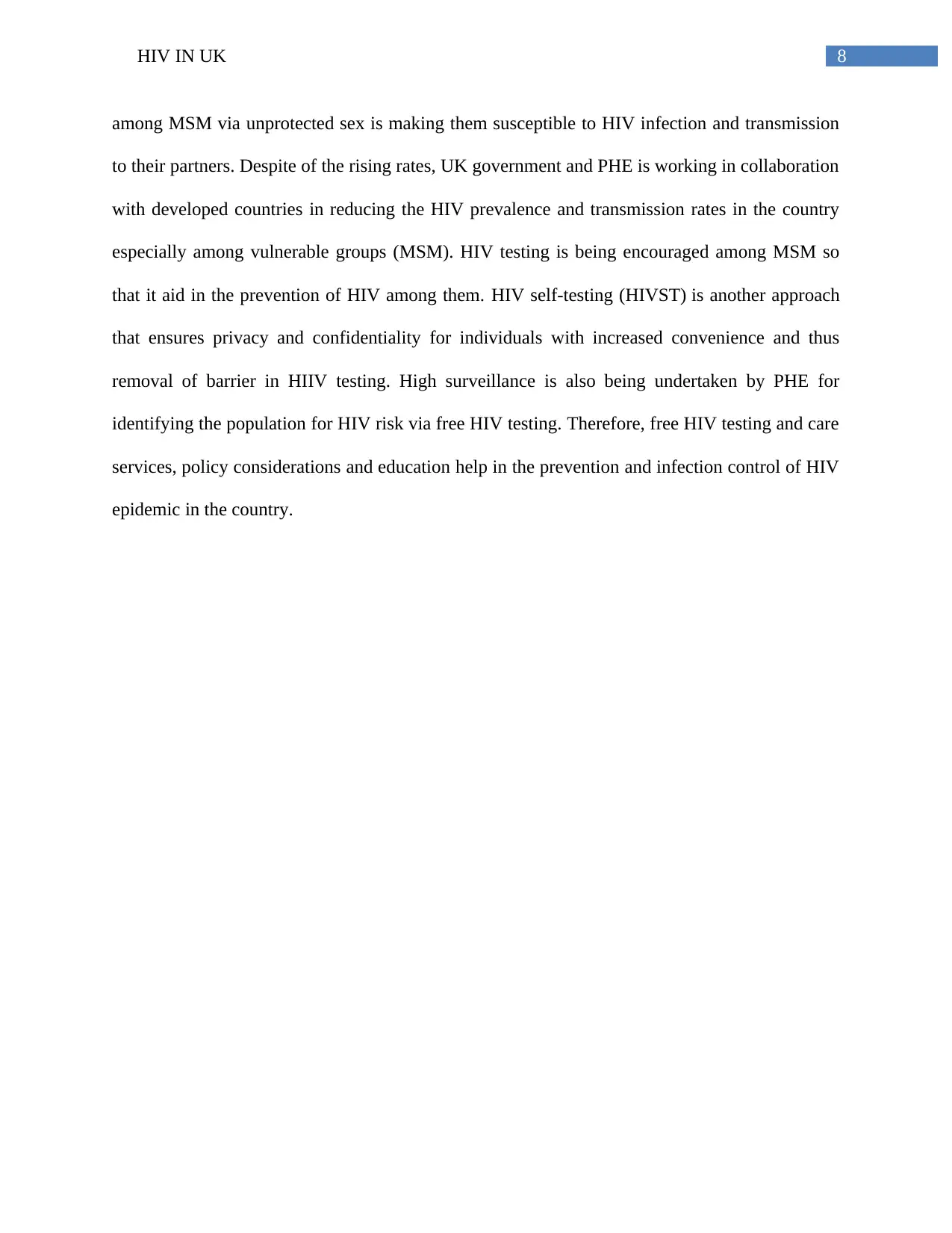
8HIV IN UK
among MSM via unprotected sex is making them susceptible to HIV infection and transmission
to their partners. Despite of the rising rates, UK government and PHE is working in collaboration
with developed countries in reducing the HIV prevalence and transmission rates in the country
especially among vulnerable groups (MSM). HIV testing is being encouraged among MSM so
that it aid in the prevention of HIV among them. HIV self-testing (HIVST) is another approach
that ensures privacy and confidentiality for individuals with increased convenience and thus
removal of barrier in HIIV testing. High surveillance is also being undertaken by PHE for
identifying the population for HIV risk via free HIV testing. Therefore, free HIV testing and care
services, policy considerations and education help in the prevention and infection control of HIV
epidemic in the country.
among MSM via unprotected sex is making them susceptible to HIV infection and transmission
to their partners. Despite of the rising rates, UK government and PHE is working in collaboration
with developed countries in reducing the HIV prevalence and transmission rates in the country
especially among vulnerable groups (MSM). HIV testing is being encouraged among MSM so
that it aid in the prevention of HIV among them. HIV self-testing (HIVST) is another approach
that ensures privacy and confidentiality for individuals with increased convenience and thus
removal of barrier in HIIV testing. High surveillance is also being undertaken by PHE for
identifying the population for HIV risk via free HIV testing. Therefore, free HIV testing and care
services, policy considerations and education help in the prevention and infection control of HIV
epidemic in the country.
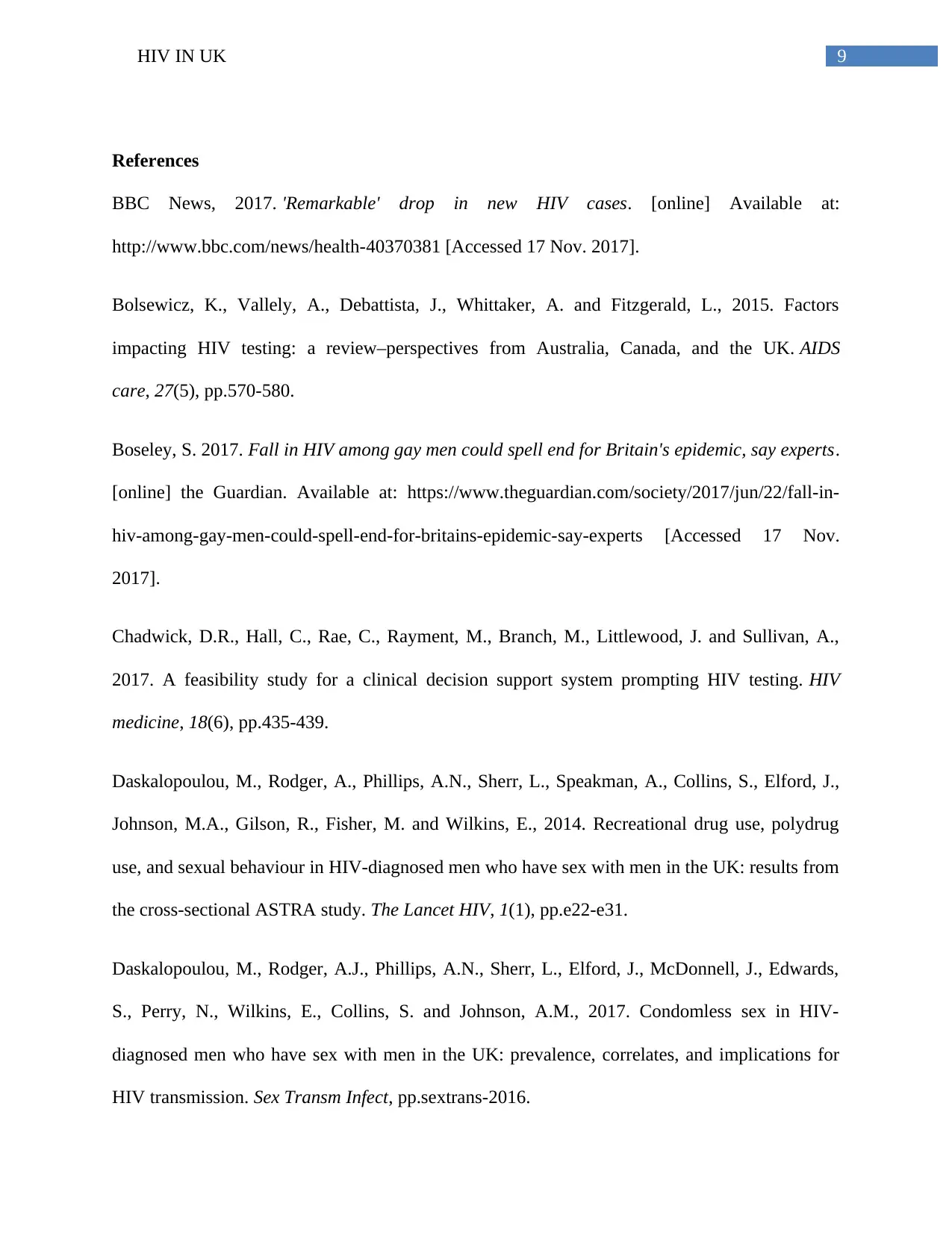
9HIV IN UK
References
BBC News, 2017. 'Remarkable' drop in new HIV cases. [online] Available at:
http://www.bbc.com/news/health-40370381 [Accessed 17 Nov. 2017].
Bolsewicz, K., Vallely, A., Debattista, J., Whittaker, A. and Fitzgerald, L., 2015. Factors
impacting HIV testing: a review–perspectives from Australia, Canada, and the UK. AIDS
care, 27(5), pp.570-580.
Boseley, S. 2017. Fall in HIV among gay men could spell end for Britain's epidemic, say experts.
[online] the Guardian. Available at: https://www.theguardian.com/society/2017/jun/22/fall-in-
hiv-among-gay-men-could-spell-end-for-britains-epidemic-say-experts [Accessed 17 Nov.
2017].
Chadwick, D.R., Hall, C., Rae, C., Rayment, M., Branch, M., Littlewood, J. and Sullivan, A.,
2017. A feasibility study for a clinical decision support system prompting HIV testing. HIV
medicine, 18(6), pp.435-439.
Daskalopoulou, M., Rodger, A., Phillips, A.N., Sherr, L., Speakman, A., Collins, S., Elford, J.,
Johnson, M.A., Gilson, R., Fisher, M. and Wilkins, E., 2014. Recreational drug use, polydrug
use, and sexual behaviour in HIV-diagnosed men who have sex with men in the UK: results from
the cross-sectional ASTRA study. The Lancet HIV, 1(1), pp.e22-e31.
Daskalopoulou, M., Rodger, A.J., Phillips, A.N., Sherr, L., Elford, J., McDonnell, J., Edwards,
S., Perry, N., Wilkins, E., Collins, S. and Johnson, A.M., 2017. Condomless sex in HIV-
diagnosed men who have sex with men in the UK: prevalence, correlates, and implications for
HIV transmission. Sex Transm Infect, pp.sextrans-2016.
References
BBC News, 2017. 'Remarkable' drop in new HIV cases. [online] Available at:
http://www.bbc.com/news/health-40370381 [Accessed 17 Nov. 2017].
Bolsewicz, K., Vallely, A., Debattista, J., Whittaker, A. and Fitzgerald, L., 2015. Factors
impacting HIV testing: a review–perspectives from Australia, Canada, and the UK. AIDS
care, 27(5), pp.570-580.
Boseley, S. 2017. Fall in HIV among gay men could spell end for Britain's epidemic, say experts.
[online] the Guardian. Available at: https://www.theguardian.com/society/2017/jun/22/fall-in-
hiv-among-gay-men-could-spell-end-for-britains-epidemic-say-experts [Accessed 17 Nov.
2017].
Chadwick, D.R., Hall, C., Rae, C., Rayment, M., Branch, M., Littlewood, J. and Sullivan, A.,
2017. A feasibility study for a clinical decision support system prompting HIV testing. HIV
medicine, 18(6), pp.435-439.
Daskalopoulou, M., Rodger, A., Phillips, A.N., Sherr, L., Speakman, A., Collins, S., Elford, J.,
Johnson, M.A., Gilson, R., Fisher, M. and Wilkins, E., 2014. Recreational drug use, polydrug
use, and sexual behaviour in HIV-diagnosed men who have sex with men in the UK: results from
the cross-sectional ASTRA study. The Lancet HIV, 1(1), pp.e22-e31.
Daskalopoulou, M., Rodger, A.J., Phillips, A.N., Sherr, L., Elford, J., McDonnell, J., Edwards,
S., Perry, N., Wilkins, E., Collins, S. and Johnson, A.M., 2017. Condomless sex in HIV-
diagnosed men who have sex with men in the UK: prevalence, correlates, and implications for
HIV transmission. Sex Transm Infect, pp.sextrans-2016.
Secure Best Marks with AI Grader
Need help grading? Try our AI Grader for instant feedback on your assignments.
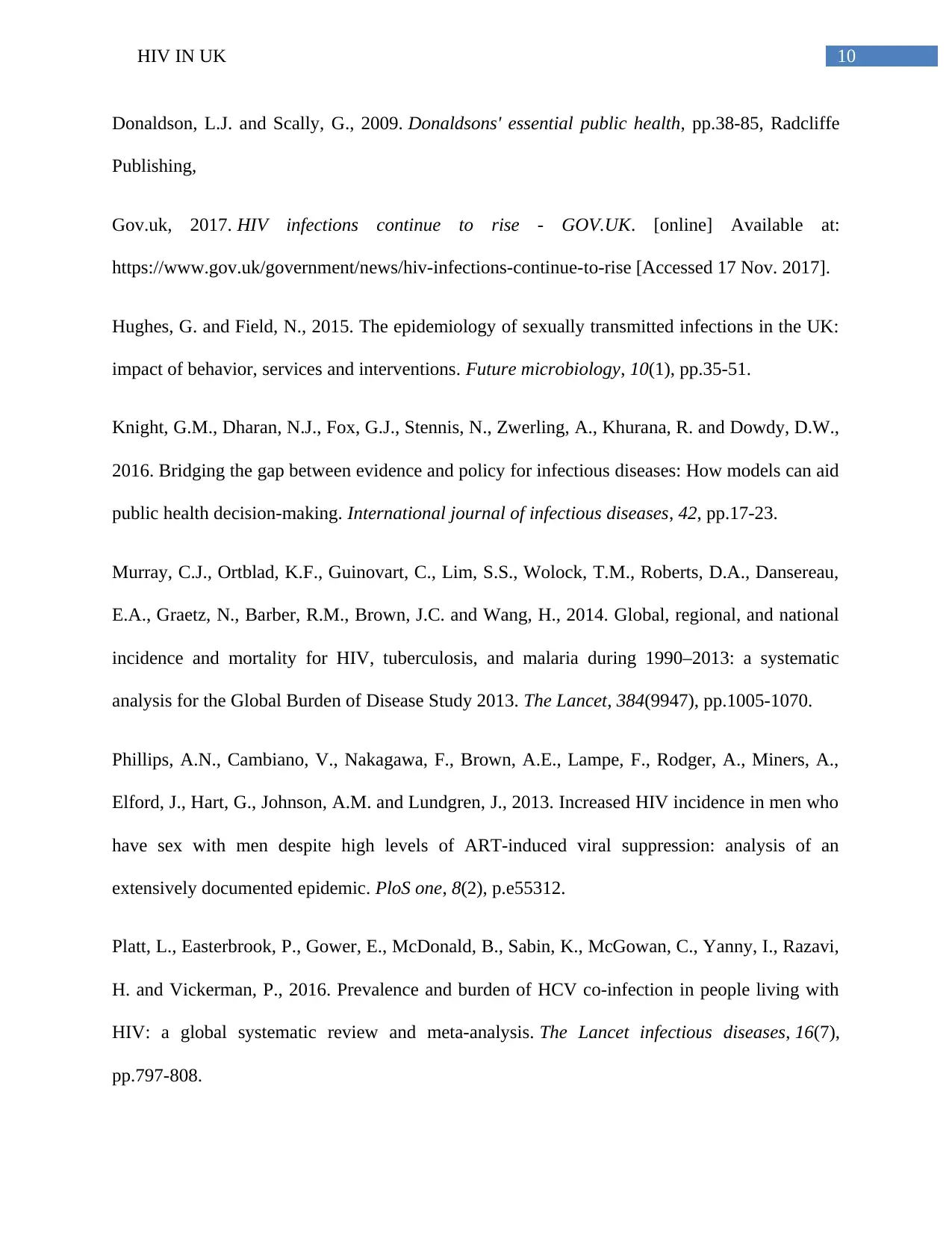
10HIV IN UK
Donaldson, L.J. and Scally, G., 2009. Donaldsons' essential public health, pp.38-85, Radcliffe
Publishing,
Gov.uk, 2017. HIV infections continue to rise - GOV.UK. [online] Available at:
https://www.gov.uk/government/news/hiv-infections-continue-to-rise [Accessed 17 Nov. 2017].
Hughes, G. and Field, N., 2015. The epidemiology of sexually transmitted infections in the UK:
impact of behavior, services and interventions. Future microbiology, 10(1), pp.35-51.
Knight, G.M., Dharan, N.J., Fox, G.J., Stennis, N., Zwerling, A., Khurana, R. and Dowdy, D.W.,
2016. Bridging the gap between evidence and policy for infectious diseases: How models can aid
public health decision-making. International journal of infectious diseases, 42, pp.17-23.
Murray, C.J., Ortblad, K.F., Guinovart, C., Lim, S.S., Wolock, T.M., Roberts, D.A., Dansereau,
E.A., Graetz, N., Barber, R.M., Brown, J.C. and Wang, H., 2014. Global, regional, and national
incidence and mortality for HIV, tuberculosis, and malaria during 1990–2013: a systematic
analysis for the Global Burden of Disease Study 2013. The Lancet, 384(9947), pp.1005-1070.
Phillips, A.N., Cambiano, V., Nakagawa, F., Brown, A.E., Lampe, F., Rodger, A., Miners, A.,
Elford, J., Hart, G., Johnson, A.M. and Lundgren, J., 2013. Increased HIV incidence in men who
have sex with men despite high levels of ART-induced viral suppression: analysis of an
extensively documented epidemic. PloS one, 8(2), p.e55312.
Platt, L., Easterbrook, P., Gower, E., McDonald, B., Sabin, K., McGowan, C., Yanny, I., Razavi,
H. and Vickerman, P., 2016. Prevalence and burden of HCV co-infection in people living with
HIV: a global systematic review and meta-analysis. The Lancet infectious diseases, 16(7),
pp.797-808.
Donaldson, L.J. and Scally, G., 2009. Donaldsons' essential public health, pp.38-85, Radcliffe
Publishing,
Gov.uk, 2017. HIV infections continue to rise - GOV.UK. [online] Available at:
https://www.gov.uk/government/news/hiv-infections-continue-to-rise [Accessed 17 Nov. 2017].
Hughes, G. and Field, N., 2015. The epidemiology of sexually transmitted infections in the UK:
impact of behavior, services and interventions. Future microbiology, 10(1), pp.35-51.
Knight, G.M., Dharan, N.J., Fox, G.J., Stennis, N., Zwerling, A., Khurana, R. and Dowdy, D.W.,
2016. Bridging the gap between evidence and policy for infectious diseases: How models can aid
public health decision-making. International journal of infectious diseases, 42, pp.17-23.
Murray, C.J., Ortblad, K.F., Guinovart, C., Lim, S.S., Wolock, T.M., Roberts, D.A., Dansereau,
E.A., Graetz, N., Barber, R.M., Brown, J.C. and Wang, H., 2014. Global, regional, and national
incidence and mortality for HIV, tuberculosis, and malaria during 1990–2013: a systematic
analysis for the Global Burden of Disease Study 2013. The Lancet, 384(9947), pp.1005-1070.
Phillips, A.N., Cambiano, V., Nakagawa, F., Brown, A.E., Lampe, F., Rodger, A., Miners, A.,
Elford, J., Hart, G., Johnson, A.M. and Lundgren, J., 2013. Increased HIV incidence in men who
have sex with men despite high levels of ART-induced viral suppression: analysis of an
extensively documented epidemic. PloS one, 8(2), p.e55312.
Platt, L., Easterbrook, P., Gower, E., McDonald, B., Sabin, K., McGowan, C., Yanny, I., Razavi,
H. and Vickerman, P., 2016. Prevalence and burden of HCV co-infection in people living with
HIV: a global systematic review and meta-analysis. The Lancet infectious diseases, 16(7),
pp.797-808.
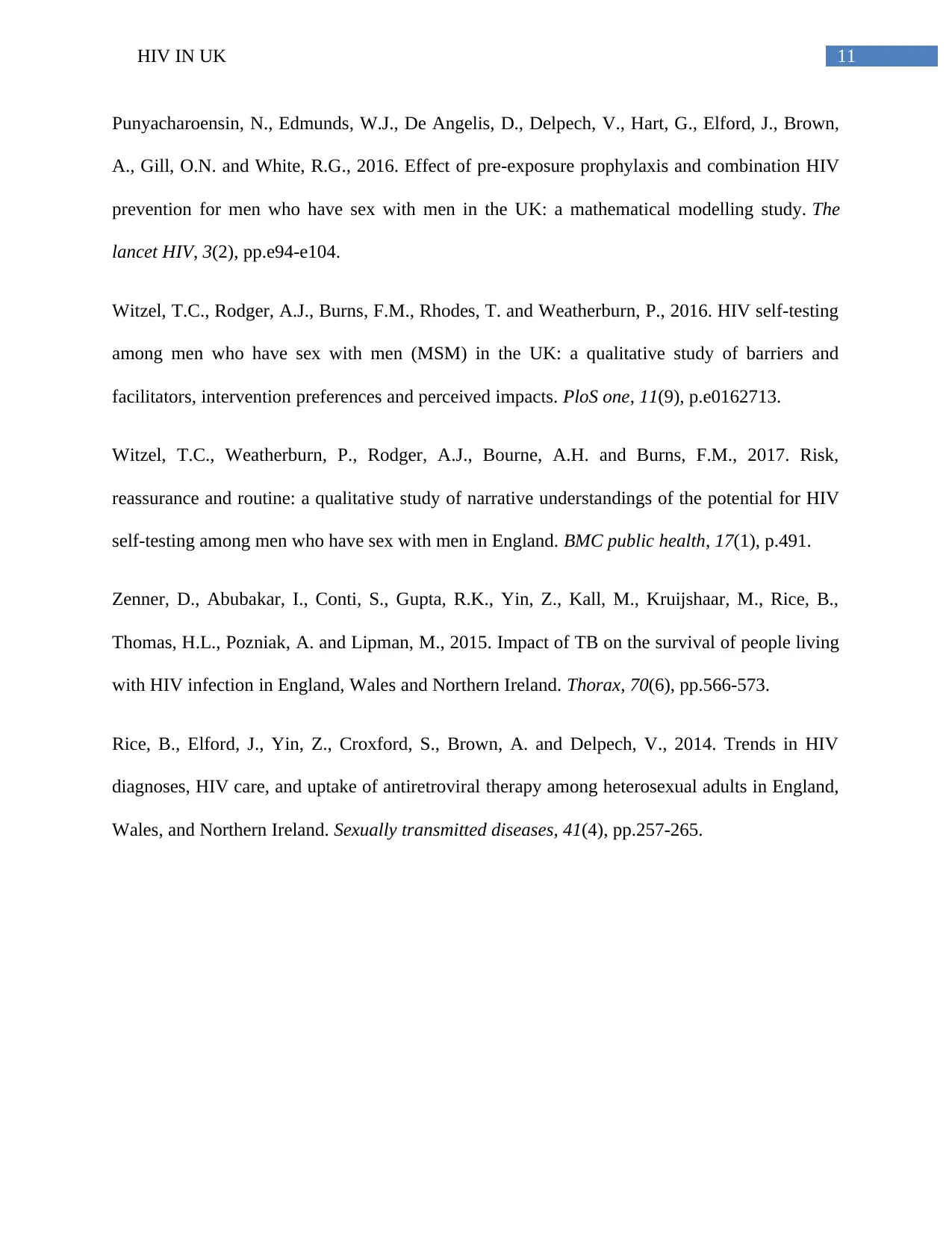
11HIV IN UK
Punyacharoensin, N., Edmunds, W.J., De Angelis, D., Delpech, V., Hart, G., Elford, J., Brown,
A., Gill, O.N. and White, R.G., 2016. Effect of pre-exposure prophylaxis and combination HIV
prevention for men who have sex with men in the UK: a mathematical modelling study. The
lancet HIV, 3(2), pp.e94-e104.
Witzel, T.C., Rodger, A.J., Burns, F.M., Rhodes, T. and Weatherburn, P., 2016. HIV self-testing
among men who have sex with men (MSM) in the UK: a qualitative study of barriers and
facilitators, intervention preferences and perceived impacts. PloS one, 11(9), p.e0162713.
Witzel, T.C., Weatherburn, P., Rodger, A.J., Bourne, A.H. and Burns, F.M., 2017. Risk,
reassurance and routine: a qualitative study of narrative understandings of the potential for HIV
self-testing among men who have sex with men in England. BMC public health, 17(1), p.491.
Zenner, D., Abubakar, I., Conti, S., Gupta, R.K., Yin, Z., Kall, M., Kruijshaar, M., Rice, B.,
Thomas, H.L., Pozniak, A. and Lipman, M., 2015. Impact of TB on the survival of people living
with HIV infection in England, Wales and Northern Ireland. Thorax, 70(6), pp.566-573.
Rice, B., Elford, J., Yin, Z., Croxford, S., Brown, A. and Delpech, V., 2014. Trends in HIV
diagnoses, HIV care, and uptake of antiretroviral therapy among heterosexual adults in England,
Wales, and Northern Ireland. Sexually transmitted diseases, 41(4), pp.257-265.
Punyacharoensin, N., Edmunds, W.J., De Angelis, D., Delpech, V., Hart, G., Elford, J., Brown,
A., Gill, O.N. and White, R.G., 2016. Effect of pre-exposure prophylaxis and combination HIV
prevention for men who have sex with men in the UK: a mathematical modelling study. The
lancet HIV, 3(2), pp.e94-e104.
Witzel, T.C., Rodger, A.J., Burns, F.M., Rhodes, T. and Weatherburn, P., 2016. HIV self-testing
among men who have sex with men (MSM) in the UK: a qualitative study of barriers and
facilitators, intervention preferences and perceived impacts. PloS one, 11(9), p.e0162713.
Witzel, T.C., Weatherburn, P., Rodger, A.J., Bourne, A.H. and Burns, F.M., 2017. Risk,
reassurance and routine: a qualitative study of narrative understandings of the potential for HIV
self-testing among men who have sex with men in England. BMC public health, 17(1), p.491.
Zenner, D., Abubakar, I., Conti, S., Gupta, R.K., Yin, Z., Kall, M., Kruijshaar, M., Rice, B.,
Thomas, H.L., Pozniak, A. and Lipman, M., 2015. Impact of TB on the survival of people living
with HIV infection in England, Wales and Northern Ireland. Thorax, 70(6), pp.566-573.
Rice, B., Elford, J., Yin, Z., Croxford, S., Brown, A. and Delpech, V., 2014. Trends in HIV
diagnoses, HIV care, and uptake of antiretroviral therapy among heterosexual adults in England,
Wales, and Northern Ireland. Sexually transmitted diseases, 41(4), pp.257-265.
1 out of 12
Related Documents
Your All-in-One AI-Powered Toolkit for Academic Success.
+13062052269
info@desklib.com
Available 24*7 on WhatsApp / Email
![[object Object]](/_next/static/media/star-bottom.7253800d.svg)
Unlock your academic potential
© 2024 | Zucol Services PVT LTD | All rights reserved.




